|
Report from
Europe
Paris 2024 Olympics¡¯ timber commitment excludes
tropical suppliers
Timber use in France has been given a massive boost by
the French government¡±s commitment to ensure that the
Paris 2024 Olympics is the first ¡°climate positive¡± sports
event and by their desire to ensure this leaves a lasting
legacy in the French construction sector.
But this commitment will play no role to support
sustainable forestry in the tropics unless the existing
prohibition on use of tropical timber for Olympic
developments is removed.
On 16 March, the Board of Directors of the Paris 2024
Olympics gave their official seal of approval to the
Games¡± climate strategy which, in line with the Paris
Agreement, aims to considerably reduce greenhouse gas
emissions and offset in excess of its residual emissions
linked to the event.
A key aim is to greatly reduce emissions during the
construction phase, notably for the 314,000 sq.m of
accommodation and other developments for the athletes¡¯
village and the 1,300 apartments being built for the media.
This should be a huge opportunity for the timber sector,
not only because of the role it can play in mitigating
carbon emissions directly associated with the Olympic
developments, but also due to the potential influence of
Olympic green procurement requirements on future
building regulations in France.
The good news for the timber sector in France is that there
is already strong recognition at the highest level of
government of its significant carbon mitigation benefits.
The French government announced in early 2020 that any
building in the Olympic development that rises more than
eight storeys must be built entirely from timber.
Partly inspired by this Olympic vision, the French
government also announced that from 2022 all new public
buildings in the country must be built from at least 50%
timber or other natural materials.
The French timber sector has formed a body, France Bois
2024, to promote wood use and press for the Olympics to
live up to commitments on environmental impact
generally and use of natural raw materials in particular.
He ¡°Cahier de Prescriptions d¡±Excellence
Environnementale¡± (¡°Environmental Excellence
Prescription¡± referred to as the CPEE 1 ), which is
developed by the Paris Olympics delivery body SOLIDEO
and is binding on all contractors involved in Olympic
Village development, includes some positive aspects for
promotion of sustainably sourced timber.
The CPEE emphasises the importance of ¡°la traçabilit¨¦
¨¦cologique des mat¨¦riaux¡± and states that the challenge is
to initiate an ¡°approche globale¡± (as in "universal" or
"holistic" rather than simply ¡°global¡±) to ensure materials
are chosen that reduce carbon emissions and protect
biodiversity.
Therefore, the meaning of ¡°la traçabilit¨¦¡± in the context of
the CPEE implies much more than just identifying the
place of origin of materials. It also requires full accounting
of environmental impacts across the product life cycle.
Wood typically performs extremely well compared to
other materials when such comprehensive accounting is
undertaken in a fair and credible manner.
The CPEE also includes a requirement to ¡°promote a
diversity of species and/or a diversity of hardwood and
softwood varieties in construction: in particular, give
priority to solid wood from various hardwoods in the nonstructural
elements of buildings.¡±
This is an encouraging sign of growing awareness of the
intrinsic value of expanding timber use away from a few
well known species to accommodate the full diversity of
timbers that forests are able to produce.
However, as so often the case with public procurement
requirements, these objective criteria in the CPEE are
undermined by a series of other requirements driven more
by political considerations, protecting certain supplier
interests and brands, than by scientific assessment of the
environmental impacts of different materials.
The CPEE requires that at least 30% of wood used for
development of the Olympic Village derives from
mainland France. All wood used must be either FSC or
PEFC certified. A serious concern for tropical suppliers,
indeed for a large proportion of non-EU suppliers, is a
specific prohibition on use of wood of tropical and boreal
origin from outside the EU.
The only exception to this prohibition is if non-EU tropical
or boreal wood is required for ¡°fire safety reasons¡±, in
which case it must be FSC certified. Even in these limited
circumstances, there is no recognition for PEFC certified
tropical or boreal timber from outside the EU. There is no
recognition at all for FLEGT licensed timber anywhere in
the CPEE requirements.
1 MIS received a copy of the CPEE but it has not been made publicly
available on the SOLIDEO website. The SOLIDEO English website is at
https://www.ouvrages-olympiques.fr/en/commitments/sustainable-city
Tropical trade associations protest against tropical
timber discrimination
An open letter signed by several tropical timber trade and
industry associations has been sent to SOLIDEO
Executive Director General Nicolas Ferrand, protesting
that the CPEE prohibition on tropical timber use is
contrary to EU competition rules and has no clear
environmental rationale.
Signatories to the letter are the Tropical Timber Technical
Association (ATIBT), the French timber traders federation
Le Commerce du Bois (LCB), the Union des Industries du
Panneau Contreplaqu¨¦ (UIPC), the Malaysian Timber
Council (MTC), the European Sustainable Tropical
Timber Coalition (STTC) and the Union des M¨¦tiers du
Bois de la F¨¦d¨¦ration Française du Bâtiment (UMB-FFB).
According to the letter, the requirement¡°seem[s] to
contravene the principle of free competition of products ¨C
a founding principle of the EU¡±. Nor, they maintain, is it
based on ¡°clearly defined environmental protection
requirements¡±.
¡°SOLIDEO¡±s position [also] does not take into account
recommendations of the French Ministry of Ecological
Transition (MET), or NGOs , such as the WWF, which,
subject to wood being supplied from forests certified for
sustainable management, do not exclude geographical
origins,¡± the letter states.
The letter also points to a statement in MET¡±s 2020
procurement guide, which supports use of sustainable
tropical timbers and maintains that if these are boycotted
¡°tropical forests lose their value [in generating] foreign
currency¡±, resulting in ¡°strong pressure to clear them for
agropastoral or agroindustrial purposes¡±.
On releasing the letter, ATIBT and LCB said that the issue
has been discussed with authorities in Cameroon, Gabon,
Republic of Congo and Malaysia ¡°in anticipation of a
future concerted approach at the political level¡±.
EU27 tropical timber imports in 2020
During the year, EU27 import value of wood furniture
from tropical countries declined 7% to US$1185 million,
while import value of tropical sawnwood declined 13% to
US$659 million, tropical mouldings were down 15% to
US$263 million, veneer down 10% to US$179 million,
joinery down 14% to US$172 million, plywood down 16%
to US$144 million, marquetry and ornaments down 14%
to US$68 million, and logs down 25% to US$41 million.
Import value of tropical flooring actually increased
slightly, up 3% to US$62 million (Chart 3).
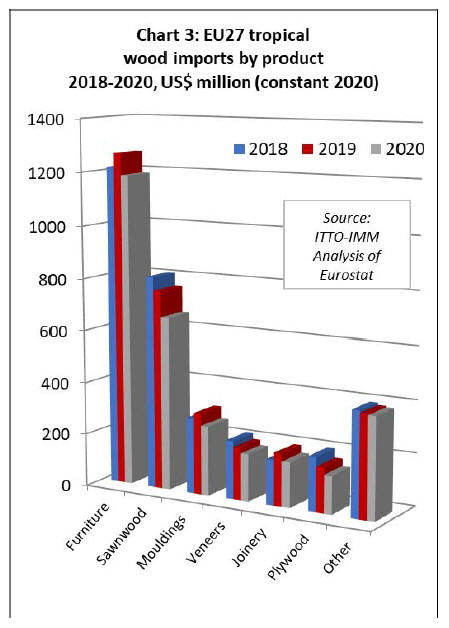
Indonesia maintained its position as the largest single
supplier of tropical wood and wood furniture products to
the EU27 in 2020 despite a 12% fall in value to US$643
million.
Imports were down 3% to US$581 million from Vietnam,
9% to US$302 million from Malaysia, 3% to US$298
million from India, 20% to US$226 million from
Cameroon, and 15% to US$223 million from Brazil.
However imports from Gabon increased 3% to US$200
million in 2020. (Chart 4)
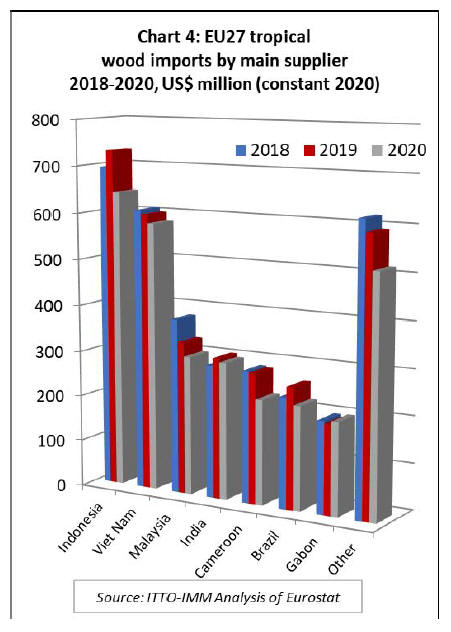
Import values fell into all six of the largest EU27
destinations for tropical wood and wood furniture products
in 2020. Import value was down 12% to US$606 million
in the Netherlands, 9% to US$570 million in France, 9%
to US$465 million in Germany, 6% to US$455 million in
Belgium, 16% to US$221 million in Italy, and 14% to
US$151 million in Spain.
However, import value increased in Denmark, by 18% to
US$134 million, and in Poland, by 20% to US$80 million.
Import value in Sweden declined, but by only 6% to
US$63 million (Chart 5).
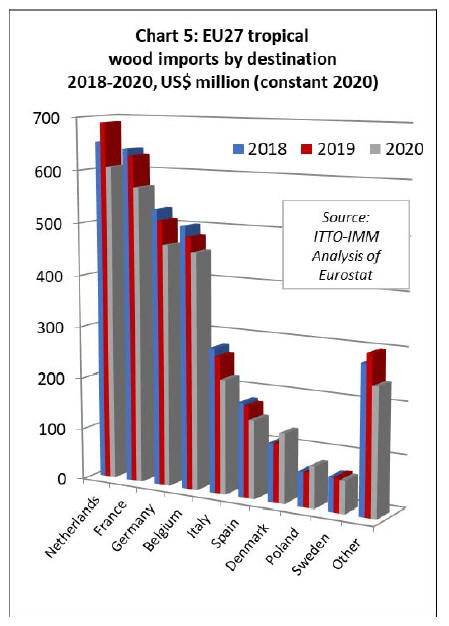
EU27 wood furniture imports from Vietnam close to
last year¡±s level
In the furniture sector in 2020, EU27 imports from
Vietnam were down only 4% to US$484 million in 2020,
having recovered strongly from a sharp dip during the first
lockdown. Imports from Indonesia were down 9% to
US$317 million in 2020, although this compares with a
strong performance in 2019 and imports were still higher
than in 2018 (Chart 6).
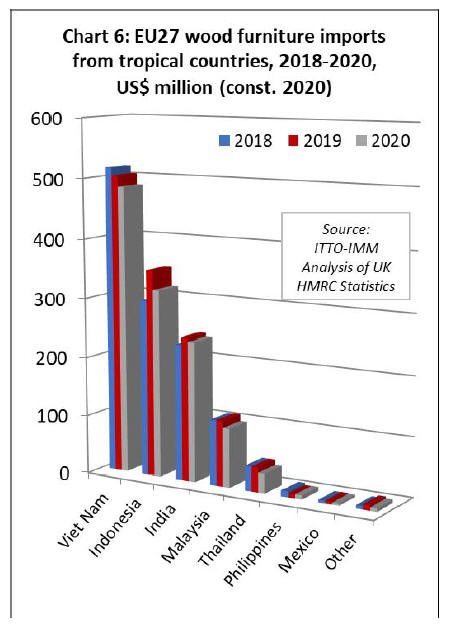
EU27 imports of wood furniture declined sharply from
Malaysia and Thailand in 2020, respectively down 11% to
US$99 million and 21% to US$33 million. However
imports from the Philippines increased 5% to US$7.0
million.
EU27 imports of wood furniture from India were down
only 3% to US$236 million in 2020. Partly due to supply
side issues, imports from furniture from India almost came
to a complete halt in May last year but rebounded very
strongly in the second half of 2020 when they were at
record levels for that time of year.
EU27 tropical sawnwood imports at record low in 2020
In quantity terms, EU27 imports of tropical sawnwood
declined 18% to 783,500 cu.m in 2020, the lowest level
ever recorded for this group of countries (well below the
previous low of 836,000 cu.m in 2017).
Imports fell sharply from all major supply countries; down
19% to 276,800 cu.m from Cameroon, 26% to 124,000
cu.m from Brazil, 11% to 102,100 cu.m from Gabon, 11%
to 92,100 cu.m from Malaysia, 18% to 48,500 cu.m from
Congo, 27% to 25,700 cu.m from Côte d¡±Ivoire, and 22%
to 19,400 cu.m from Ghana.
However Ecuador bucked the downward trend, with EU27
imports of sawnwood from the country rising 10% to
26,600 cu.m in 2020, much destined for Denmark and
driven by booming demand for balsa for wind turbines.
Imports of sawnwood from Indonesia also increased
sharply in 2020, by 21% to 9,000 cu.m, but this follows a
66% reduction in 2019.
There was a slight 2% rise in sawnwood imports from
Madagascar to 7,400 cu.m, while imports from Suriname
fell only 2% to 6,800 cu.m.
Imports were down 12% to 6,600 cu.m from Myanmar.
The largest percentage fall in imports was from DRC,
down 39% to only 6,200 cu.m. (Chart 7).
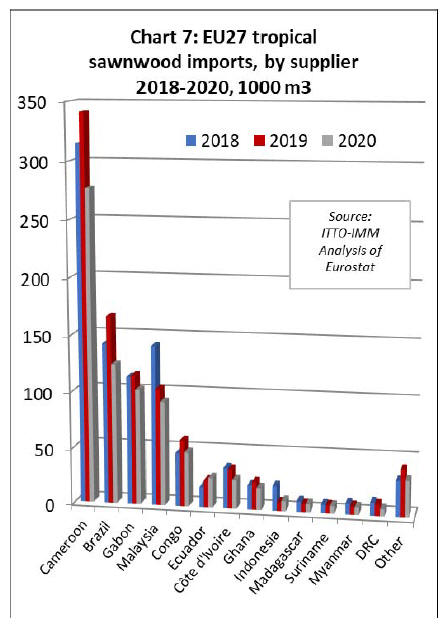
The decline in imports of tropical sawnwood in 2020 was
mirrored by a similar decline in EU27 imports of tropical
mouldings/decking. Imports of this commodity were down
6% overall at 171,300 tonnes, falling 6% from Brazil to
75,200 tonnes, 1% from Indonesia to 56,700 tonnes, 11%
from Peru to 9,700 tonnes, 12% from Malaysia to 11,500
tonnes, 27% from Gabon to 5,800 tonnes, and 21% from
Bolivia to 5,300 tonnes (Chart 8).

EU27 imports of tropical logs were down 24% to 82,900
cu.m in 2020. Imports held up reasonably well from the
Republic of Congo, down 13% to 31,600 cu.m, but fell
sharply from all other leading African supply countries
including Central African Republic (-35% to 12,200
cu.m), Cameroon (-34% to 11,500 cu.m), DRC (-47% to
7,300 cu.m), and Liberia (-25% to 5,900 cu.m).
However, there was a significant rise in imports from three
smaller suppliers in South America; Paraguay (+262% to
4,200 cu.m), Guyana (+37% to 2,300 cu.m), and Suriname
(+54% to 2,200 cu.m) (Chart 9).
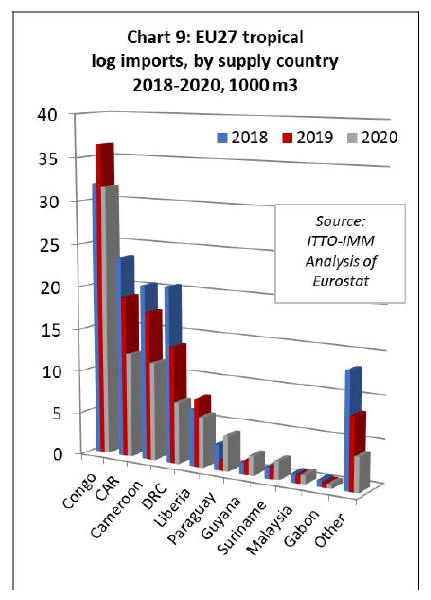
EU27 tropical veneer imports from Gabon on the rise
despite pandemic
EU27 imports of tropical veneer declined 7% to 278,700
cu.m in 2020. Imports from Gabon bucked the wider
downward trend, the EU27 importing 152,800 cu.m from
the country during the year, 16% more than in 2019,
mainly destined for France.
Veneer imports declined from all other major tropical
suppliers, including Côte d¡±Ivoire (-22% to 55,200 cu.m),
Cameroon (-35% to 25,400 cu.m), Republic of Congo (-
30% to 12,700 cu.m), Equatorial Guinea (-15% to 9,700
cu.m), Ghana (-16% to 7,300 cu.m), Indonesia (-23% to
4,400 cu.m). (Chart 10).
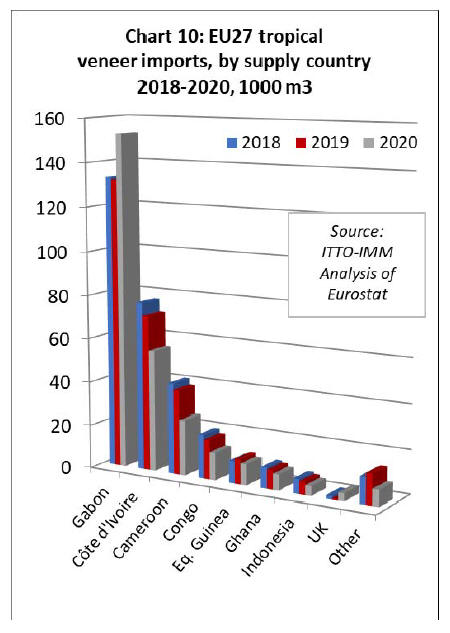
Although there were signs of an uptick in the pace of
EU27 imports of tropical hardwood faced plywood in the
last quarter of 2020, total imports of 239,900 cu.m for the
whole year were still down 15% compared to 2019.
Imports fell from all the leading supply countries
including Indonesia (-16% to 76,200 cu.m), China (-9% to
72,900 cu.m), Gabon (-8% to 26,500 cu.m), Vietnam (-
14% to 13,500 cu.m), Morocco (-5% to 11,200 cu.m),
Brazil (-33% to 8,600 cu.m), and Malaysia (-14% to 8,300
cu.m). EU27 imports of tropical hardwood faced plywood
from the UK ¨C a re-export since the UK has no plywood
manufacturing capacity - declined 36% to 12,100 cu.m in
2020 (Chart 11).
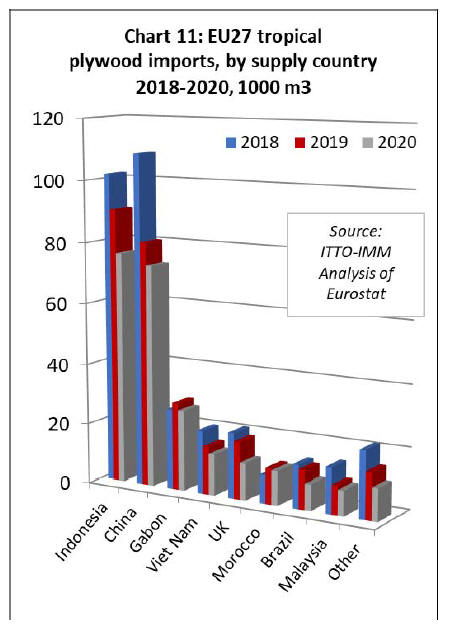
EU27 tropical flooring imports rise while other joinery
imports decline
Given the situation in the wider market, one of the least
expected trends in 2020 was a slight recovery in EU27
imports of tropical flooring products. This follows a long
period of continuous decline. Imports increased 4% to
24,200 tonnes during the year, the gain due primarily to a
37% rise in imports from Malaysia to 9,000 tonnes, mostly
destined for Belgium. Imports from Indonesia also
increased slightly, by 3% to 5,900 tonnes.

However imports declined sharply from Brazil, down 16%
to 5,000 tonnes and Vietnam, down 22% to 2,300 cu.m
(Chart 12).
EU27 import quantity of other joinery products from
tropical countries, which mainly comprise laminated
window scantlings, kitchen tops and wood doors, declined
14% to 171,800 tonnes in 2020. Imports were down 20%
to 86,400 tonnes from Indonesia, 9% to 54,400 tonnes
from Malaysia, and 38% to 1,700 tonnes from Ghana.
However, imports increased by 5% to 16,900 tonnes from
Vietnam, 11% to 3,600 tonnes from the Republic of
Congo, 26% to 2,000 tonnes from Brazil, and 41% to
1,200 tonnes from India. (Chart 13).
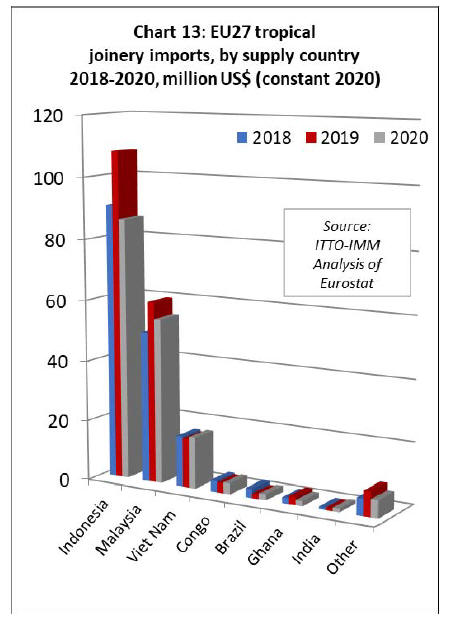
|